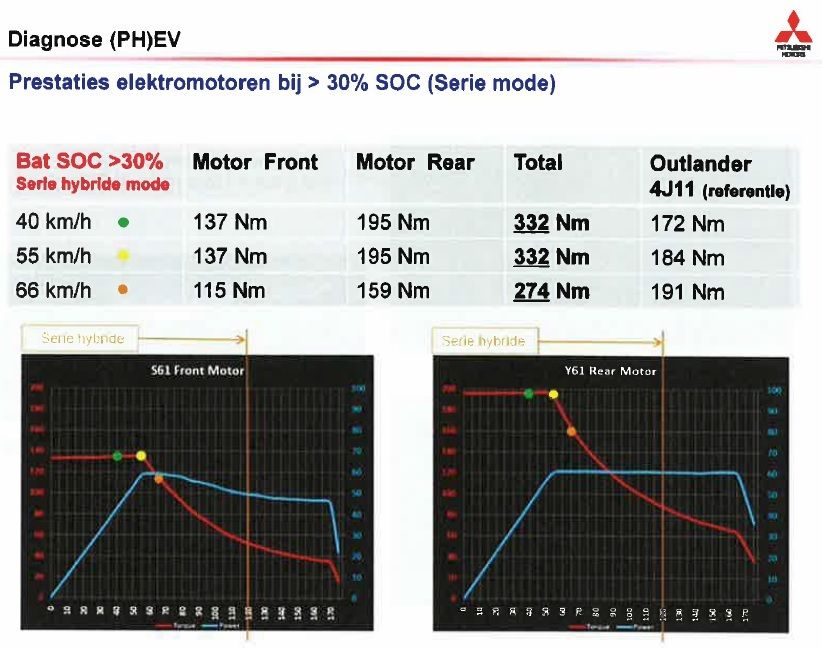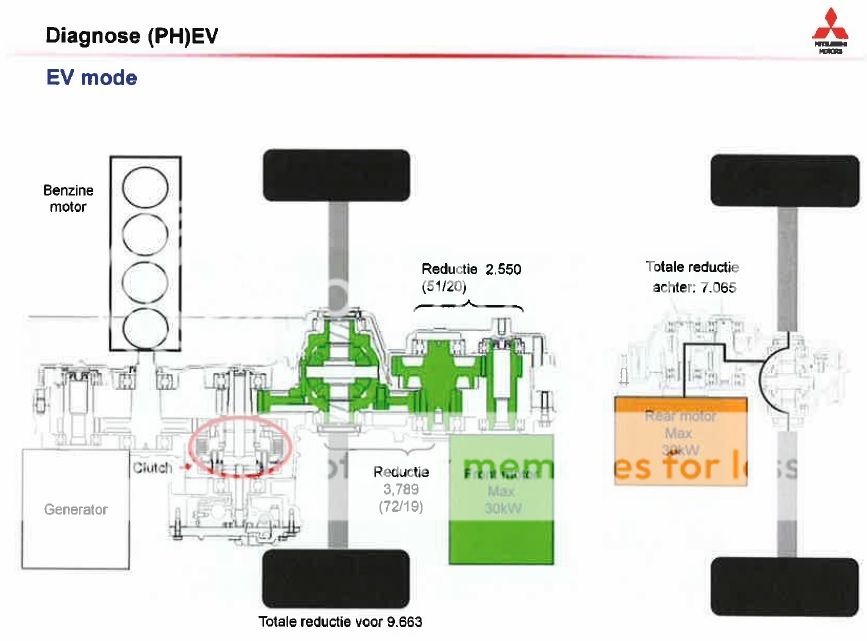anko
Well-known member
Looking for stuff like this? ;-)
http://www.myoutlanderphev.com/forum/viewtopic.php?p=23697#p23697
http://www.myoutlanderphev.com/forum/viewtopic.php?p=23697#p23697

anko said:But it does matter. A lot. As you say, in EV mode we have 60 kW available that can / could be distributed over front and rear axles. So, (in theory) we do not have to loose any power. But torque is not limited by the battery, but by the specs of the motors. Like it or not, we loose half of the available torque when one axle has no grip. and the remaining torque may simply not be enough to get going.
I agree with you that not being able to transfer torque does not necessarily explain why the car doesn't move. In other words: why is half of the torque not enough. I was just trying to explain why we cannot electronically reproduce the effect of a locking center diff, which can transfer torque from one axle to the other ;-)Grigou said:anko said:But it does matter. A lot. As you say, in EV mode we have 60 kW available that can / could be distributed over front and rear axles. So, (in theory) we do not have to loose any power. But torque is not limited by the battery, but by the specs of the motors. Like it or not, we loose half of the available torque when one axle has no grip. and the remaining torque may simply not be enough to get going.
It does not matter for me because it's somewhere the same thing. "Somewhere" is an important word in the context of courseThe angular speed makes the difference.
I agree with the fact that we loose half of the torque when one axle has no grip. It's because I agree that my question is : where is the second half ? The car don't even move for 2 cms !
And why the spinning wheel is not braked ? It should, at least if we don't push any switch ... :?:

You mean like this.pasquinade said:assuming what I found in some forum pictures (great info, thanks!):
195Nm Stall Torque and 7.065 gearbox for one of the axles and
137Nm Stall Torque and 9.663 gearbox for the other axle


MartinH said:The system does not work, ONE! (i have never seen 2) of the front Wheels stars to spinn, you have to push the accelerometer more to get the back Wheel(Always only one) to start pushing. You do not know the front whelle is spinning until the window is covered in mud as you do not hear is spinning, and you can not see on the dash.
MartinH said:I heard something about the tyres, and yes, tyres are important, to avoid using special tyres and chains i use 4WD cars.....
MartinH said:Sorry!, i forgot to answer.
The PHEV has Nokian Hakka R unstudded Winter tyres 225/50-18, very expensive.
From your own explanation (which I agree with), should you not add "once the motor is spinning"?pasquinade said:...but this is to say you can have a lot of torque without having a great battery consumption
Not split, but transfer.Esparza said:A center lock diff does not split torque or power, just equalize RPM.
pasquinade said:Hi Trex,
I think we might have a Torque vs Power issue:
Torque is physically measured in Nm, or Joule (energy) per radian. Electrically it should be proportional to the current going through the motor, but this is after back emf is included together with internal resistance so not extremely simple to go in to here. Just assume that the max stall torque is the curve we’ve all seen and it occurs for a given amount of electrical power.
Power is physically equivalent to torque times angular velocity and electrically equivalent to current squared times the internal resistance.
Normally, mechanical power (driving the car forward) should be close to electrical power (consumed from the batteries and generator). The difference comes out as wasted heat.
But the detail is in the “close”. It is not exact and heat is inevitable. Notice that when angular velocity (rpm) is 0, mechanical power is 0. So all the electrical power consumed from the battery is being wasted as heat. As a “side-effect” the motor produces a torque (but no mechanical power), which is also in this case the maximum motor torque.
I think I might have been a bit confusing, but this is to say you can have a lot of torque without having a great battery consumption (e.g. with a large enough “perfect” gearbox you can have a AAA battery and a children’s toy motor creating more torque than the PHEV. What you cannot have is a lot of mechanical power (torque times speed) without having a lot of battery consumption (the child toy example will always be extremely slow).
Hope it helps
Ricardo
Trex said:His second mistake was not getting into it in the first place. He should have accelerated more to create more momentum.
Ok this is where I hear you say how do you know he did not get into it.?
Because I cannot hear the petrol motor having a decent go at the job.
We hear the petrol motor rev just for a second after he has already lost traction.
We do not see him (hear him ) push that petrol motor to supply the extra torque, energy, through the generator, that is needed to get the most out of the current PHEV.
anko said:From your own explanation (which I agree with), should you not add "once the motor is spinning"?
Because otherwise, why would you, under some circumstances, have to push the throttle to the point where the ICE kicks in, before you get going? Or do you think this can be prevented at all times?
Maybe the engine only kicks in as a response to "you flooring it to quickly without having a PHEVbox installed".
anko said:From your own explanation (which I agree with), should you not add "once the motor is spinning"?pasquinade said:...but this is to say you can have a lot of torque without having a great battery consumption
Enter your email address to join: